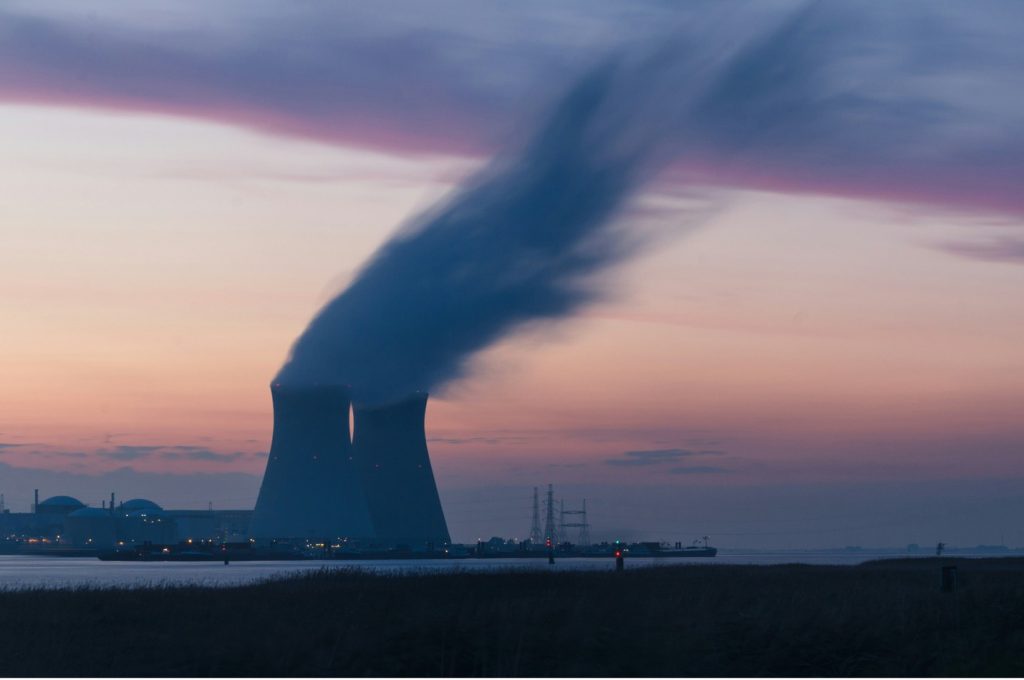By Zachary Atkins, Staff Writer

Photo Courtesy of Unsplash.com
Since the federal government loosened its grip on atomic energy in 1954, allowing private development of nuclear power for peaceful purposes, the trajectory of nuclear energy in the United States has been marked by highs and lows.[1] Initial enthusiasm was dampened by political, economic, and safety concerns, leading to a period of stagnation. However, recent shifts in energy demands and technological advancements have reignited interest in nuclear power.[2]
Prior to 1954, the federal government held full control over nuclear technology.[3] However, under strict federal regulation, the Atomic Energy Act of 1954 (AEA) shifted towards private development for peaceful purposes.[4] This allowed private entities to own and operate nuclear power reactors under Atomic Energy Commission (AEC) supervision.[5] The AEA granted the AEC exclusive jurisdiction over nuclear materials, limiting states’ roles. In 1959, amendments to the AEA expanded state regulatory authority over nuclear materials under certain conditions. These changes aimed to clarify state and federal responsibilities while affirming the AEC’s control over nuclear power plant construction and operation.[6] The AEC’s successor, the Nuclear Regulatory Commission (NRC), has since enforced detailed regulations on nuclear facility operations and waste storage.[7]
The 1959 amendments aimed to clarify state and federal roles in regulating nuclear power but led to ongoing uncertainty, prompting judicial interpretation. In 1983, the Supreme Court upheld a California law halting new nuclear power plants until a disposal solution was found.[8] It ruled that states could enact laws based on economic concerns, not just safety. States could decide on the need for nuclear power, but federal authority governed plant construction and operation, preempting state laws with safety motives. Subsequent cases like Silkwood v. Kerr-McGee Corp. (1984) and English v. General Electric Co. (1990) refined preemption criteria. In Skull Valley Band of Goshute Indians v. Nielson (2005), Utah statutes regulating nuclear waste were struck down for safety concerns.[9] Manning (2008) voided Washington’s Cleanup Priority Act for impacting radiological safety. Lastly, Entergy Nuclear Vermont Yankee v. Shumlin (2013) found Vermont’s statutes on nuclear plant operation preempted, as their true intent was safety, despite professed policy goals.[10] These cases define the balance between state and federal authority in nuclear regulation.
Courts acknowledge the Nuclear Regulatory Commission’s (NRC) exclusive control over radiological safety in nuclear power plant operations, yet defining the exact extent of preemption has been challenging.[11] This ambiguity has led to varied interpretations of the Atomic Energy Act (AEA), resulting in inconclusive legal precedents.[12] Despite this, states maintain authority over certain aspects of nuclear power decisions, such as determining the need for new plants and economic feasibility.[13] States have implemented diverse laws to regulate nuclear power, often avoiding safety-related issues and focusing on initial assessments of need and feasibility. Congress retains the power to adjust the AEA’s preemptive scope through legislation, enabling it to address any perceived misuse of state authority or clarify regulatory boundaries. The Supreme Court has urged Congress to reassess regulatory divisions to ensure federal objectives are upheld, emphasizing that it is Congress’s role to define the balance between state and federal authority in nuclear regulation. Without action, the promise of clean and cheap energy provided by nuclear reactors will continue to stall in the United States.
[1] Michael Mobilia, Most U.S. Nuclear Power Plants Were Built between 1970 and 1990, U.S. ENERGY INFORMATION ADMINISTRATION (Apr. 27, 2017), http://www.eia.gov/todayinenergy/detail.cfm?id=30972.
[2] Elesia Fasching, Tyler Hodge, & Slade Johnson, First New U.S. Nuclear Reactor Since 2016 Is Now in Operation, U.S. ENERGY INFORMATION ADMINISTRATION (Aug. 1, 2023), https://www.eia.gov/todayinenergy/detail.php?id=57280
[3] Atomic Energy Commission State Cooperation Act, P.L. 86-373, 78 Stat. 688 (1959) (Codified at 42 U.S.C. § 2021)
[4] Id.
[5] Andrew I. Fillat & Henry I. Miller, Nuclear Power Is the Best Climate-Change Solution by Far, WALL ST.J. (Nov. 4, 2021), https://www.wsj.com/articles/nuclear-power-best-climate-change-solution-by-far-global-warmingemissions-cop26-11636056581?mod=article_inline;
[6] Joshua S. Goldstein, Staffan A. Qvist, & Steven Pinker, Nuclear Power Can Save the World, N.Y. TIMES (Apr. 6, 2019), https://www.nytimes.com/2019/04/06/opinion/sunday/climatechange-nuclear-power.html.
[7]Jason O. Heflin. November 1, 2023. State Authority to Regulate Nuclear Power: Federal Preemption Under the Atomic Energy Act (AEA).
[8] Pac. Gas & Elec. Co. v. State Energy Res. Conservation & Dev. Comm’n, 461 U.S. 190, 205 (1983)
[9] English v. Gen. Elec. Co., 496 U.S. 72, 79 (1990); see also Skull Valley Band of Goshute Indians v. Nielson, 376 F.3d 1223, 1239 (10th Cir. 2004).
[10] Matthew L. Wald, Vermont Yankee Plant to Close Next Year as the Nuclear Industry Retrenches, N.Y. TIMES (Aug. 27, 2013), https://www.nytimes.com/2013/08/28/science/entergy-announces-closing-of-vermont-nuclear-plant.html.
[11] Joshua S. Goldstein, Staffan A. Qvist, & Steven Pinker, Nuclear Power Can Save the World, N.Y. TIMES (Apr. 6, 2019).
[12] Andrew I. Fillat & Henry I. Miller, Nuclear Power Is the Best Climate-Change Solution by Far, WALL ST.J. (Nov. 4, 2021)
[13] Pacific Gas, 461 U.S. at 212.